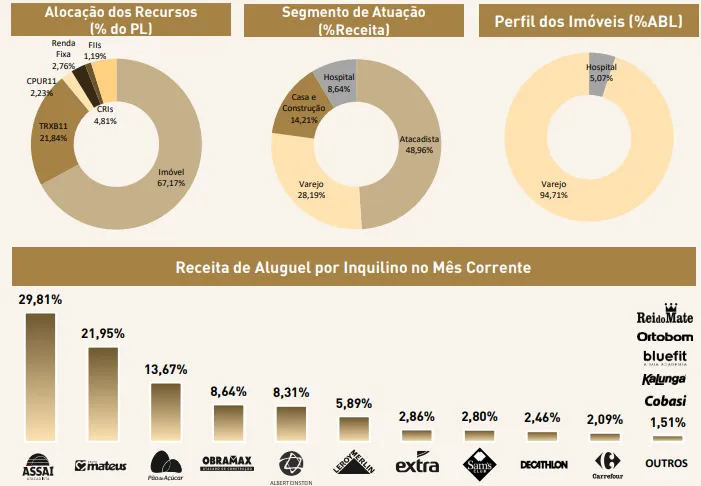Real Estate 📊| Characteristics and Examples of the Urban Income Segment! [EN/PT]

Urban Income real estate funds are part of the portfolios of several managers and figures in the FIIs sector, representing 5% to 15% of the portfolios. They have unique characteristics that make them different from shopping malls, for example, even though both have a strong retail trait. Therefore, we will talk about 3 characteristics of this segment and give two examples of real estate funds, HGRU11 and also TRXF11. Come and find out!
I'll be much appreaciated if you Upvote, Reblogs or give any Tips ( PIZZA 🍕, PGM 🎮, LOLZ 😆, ALIVE ❤️, etc ). Thanks and have good reading! 🍀

[ENGLISH VERSION]
Characteristics of the Urban Income Segment

There are some very evident characteristics of Real Estate Funds in the Urban Income sector. The first of these is the presence of Atypical Contacts, since the properties are often built in the Built to Suit model, to adapt to the needs of the specific tenant. Therefore, the contracts are usually long-term and with a large fine to protect the owner who invested in the construction. Furthermore, they do not usually undergo adjustments, being adjusted for inflation during this period. It is clear that the average term of contracts for these FIIs is quite long.
The second characteristic is their large number of properties, with funds with more than 100 properties. Another is the presence of tenants from sectors linked to retail and stores, which are from very similar sectors of commerce, usually wholesalers in the food retail segment or clothing retail stores. It is interesting to note this if you are looking for greater diversification within this sector.
HGRU11 - Retail Real Estate

HGRU11 is a true giant in the urban income segment within real estate funds, because it has a portfolio of 104 assets, together forming a portfolio of almost 3 billion reais, average daily liquidity of R$ 3 million, and a large number of shareholders. However, when compared to others in the segment, it has a lower yield of 9.62% and a P/VP of almost 1. The average term of the contracts is 9.6 years, which is a predictable income, if everything remains constant. Very low physical vacancy rate at 0.8%, with almost completely occupied properties. Leverage of 6.3%

Note that in the case of HGRU11, we have a strong presence in food retail of 51%, exposed in the tenants Carrefour (23%) and Assaí (22%). Next we have the education sector with 29%, which does not appear as much in other retail funds. Finally, the clothing retail sector is relevant, with 17% of the allocation for the Pernambucanas store. New developments in this fund include negotiations being carried out at the Dutra 107 property and the construction of the HGRU Passeio Dutra R01 has advanced to 27.1% of the physical progress.
TRXF11: Issuance of Accounts, Acquisitions and Portfolio.

The real estate fund had its 11th issuance of shares, raising more than R$1 billion, which represented an allocation of more than 8 million new shares of the fund, showing the great interest of investors. Part of this amount, R$543 million, was used to acquire a batch of 13 properties located in São Paulo, Diadema, Atibaia and Cotia, most of which are leased to Companhia de Distribuição. Thus, 12 of the properties are in the food retail sector, while one is in the middle sector, leased by Diagnósticos da América, a laboratory and clinical analysis company. Regarding the contracts, they are all typical, but with an average term of 15 years. The manager's strategy is to build a portfolio of well-located assets, leased to large companies, through long-term contracts.
Currently, with these acquisitions and new ones on the way, the TRXF11 fund is basically at the value of its equity price, with a P/BV of 0.99. It is a very robust fund with over billions of assets, with a dividend yield of 12.64%, which has been growing over the years, perhaps due to rent adjustments. It has good liquidity of more than 5 million daily and more than 180 thousand shareholders.

There are 56 properties, with 20 tenants, and vacancy close to 0%. The fund's exposure is mostly in the wholesale sector with almost 50%, with Assaí representing almost 30% of rental revenue and then Grupo Matheus with 21.95% of revenue, that is, exposed to almost 50% of revenue from two tenants in the same segment. Then there is Retail with 28.19%, Home and Construction with 14.21% and Hospital 8.64%, this being a sector that not all retail FIIs have.


Os fundos imobiliários de Renda Urbana fazem parte da carteira de diversos gestores e figuras dos setor de FIIs, representando de 5% à 15% das carteiras. Ele tem características únicas que o tornam diferentes por exemplo dos Shoppings, por mais que ambos tenham um forte traço de varejo. Por isso, vamos falar sobre 3 características desse segmento e dar dois exemplos de fundos imobiliários, o HGRU11 e também o TRXF11. Venha descobrir!
Fico agradecido se você puder dar um Upvote, Reblogs ou algum Tips ( PIZZA 🍕, PGM 🎮, LOLZ 😆, ALIVE ❤️, etc ). Obrigado e boa leitura! 🍀

[VERSÃO PORTUGUÊS]
Características do Segmento de Renda Urbana

Existem algumas características bem evidentes de Fundos Imobiliários do setor de Renda urbana. A primeira deles é a presença de Contatos Atípicos, já que muitas vez os imóveis são construídos no modelo Built to Suit, para se adequar as necessidades do inquilino específico. Por isso, os contratos costumam ser de longo prazo e com uma multa grande para proteger o proprietário que investiu na construção. Ainda, ele não costumam ter reajustes, sendo corrigidos pela inflação durante esse período. Percebe-se que a média de prazo dos contratos desses FIIs é bem longa.
A segunda caraterística é a sua grande quantidade de imóveis, com fundos com mais de 100 imóveis. Outra é a presença de inquilinos de setores ligados ao varejo e de lojas, sendo de setores do comércio bem parecidos, geralmente são atacadistas do segmento de varejo alimentício ou lojas do varejo de roupa. É interessante observar isso caso busque uma diversificação maior dentro desse setor.
HGRU11 - Imóveis de Varejo

HGRU11 é um verdadeiro gigante no segmento de renda urbana dentro os fundos imobiliários, porque apresenta um patrimônio de 104 ativos, juntos formando um portfólio de quase 3 bilhões de reais, liquidez média diária de R$ 3 milhões, um amplo número de cotistas. Entretanto, quando comparado com outros do segmento apresenta um yield menor de 9,62% e um P/VP de quase 1. O prazo médio dos contratos é de 9,6 anos, um a previsibilidade de receita, se tudo se mantiver constante. Taxa de vacância física muito baixa em 0,8%, quase completamente ocupado os imóveis. Alavancagem de 6,3%

Observe que no caso do HGRU11, temos forte presença do varejo alimentício de 51%, exposto nos inquilinos Carrefour (23%) e Assaí (22%). Em seguida temos o setor educacional com 29%, que não aparece tanto assim em outros fundos de varejo. Por fim, de relevânte tem o varejo vestuário com 17% da alocação para a loja Pernambucanas. De novidades desse fundo temos as negociações sendo realizadas no imóvel Dutra 107 e a construção do HGRU Passeio Dutra R01 avançou para 27,1% do progresso físico.
TRXF11: Emissão de Contas, Aquisições e Portfólio.

O fundo imobiliário teve a sua 11ª emissão de cotas, arrecadando mais de R$1 Bilhão, o que representou uma alocação de mais de 8 milhões de novas cotas do fundo, mostrando o grande interesse dos investidores. Parte desse valor, 543 milhões de reais, foi usada para a aquisição de um lote de 13 imóveis localizados em São Paulo, Diadema, Atibaia e Cotia, com a maioria alugado para a Companhia de Distribuição. Assim, 12 dos imóveis estão no setor de varejo alimentício, enquanto um está para o setor médio, alugado pela Diagnósticos da América, empresa de laboratórios e análises clínicas. Sobre os contratos, são todos típicos, mas com prazo médio de 15 anos. A estratégia da gestora é construir um portfólio de ativos bem localizados, alugados para grandes empresas, por meio de contratos de longo prazo.
Atualmente, com essas aquisições e novas a caminho, o fundo TRXF11 se encontra basicamente no valor do seu preço patrimonial, com 0,99 de P/VP. É um fundo bem robusto com mais de Bilhões de patrimônio, com um dividend yield de 12,64%, que vem crescendo nos anos, talvez pelos reajustes nos alugueis. Conta com uma boa liquidez de mais de 5 milhões diários e mais de 180 mil cotistas.

São 56 imóveis, com 20 inquilinos, vacância próxima de 0%. A exposição do fundo é em maior parte no setor atacadista com quase 50%, sendo o Assaí representante de quase 30% da receita de aluguel e em seguida vem a Grupo Matheus com 21,95% da receita, ou seja, exposto à quase 50% da receita à dois inquilinos do mesmo segmento. Depois tem Varejo com 28,19%, Casa e Construção com 14,21% e Hospital 8,64%, sendo esse um setor que nem todos os FIIs de varejo possuem.


If you like Crypto, Play2Earn, Finance or Anime content, consider FOLLOW me, that way you'll receive a notification when new post is done.
Thank you for reading. See ya! 👋👋
Posted Using INLEO
